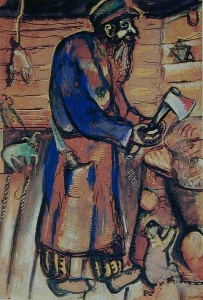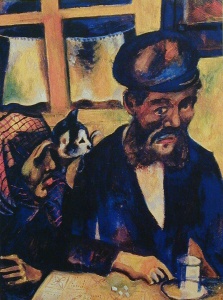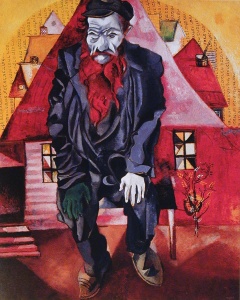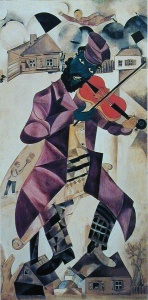Chagall in Mother Russia
If you didn’t know this was the famous Chagall, and if you didn’t know Chagall was going to become perhaps the greatest Jewish painter of the twentieth century; what would you think of the early works of this artist when he lived in Russia as a student and young man? A collection of early work (most never seen before outside of Russia) in Marc Chagall – Early Works from Russian Collections currently at the Jewish Museum allows us to examine a small portion of his work and see him in isolation before he became one of the big international names of modern art.
Marc Chagall was born in Vitebsk in 1887, received a traditional Jewish primary education under the guidance of his Hasidic parents and then, as a teenager, went to the first, and for some time, only art school in the Pale of Settlement under the tutelage of Yehuda Pen.
Yehuda Pen’s rather academic paintings, some shown here, bear almost no aesthetic relationship to the early Chagall. Rather, Pen’s most important influence was to introduce Chagall to Modern Art and to provide the crucial understanding that it was in fact possible to be a Jew and also an artist. Pen, an observant Jew, closed his school on Shabbos and Yom Tov, thought of himself as a Jewish artist and selected his subjects from the local Russian Jewish world of Vitebsk, a provincial town with a major Jewish population. Pen’s depictions of devout Jews, and craftsmen were typically sentimental and detail oriented. But, most importantly, it was the unusual combination of devotion to art and Jewish practice that made Yehuda Pen such a decisive influence on Marc Chagall.

Chagall was encouraged to further his studies in the cultural capital of Russia, St. Petersburg in 1908. There he explored modernism and studied with Leon Bakst at the Zvantseva School, then the most progressive art school in Russia. We can see in the his Butcher of 1910 that he was willing to explore his own personal subject matter with a amazing independence for a twenty-three year old provincial artist. This painting of his grandfather is infused with the tension found between religiosity and slaughter, piety and blood. At first it seems iconic, the butcher seen in profile with his hatchet and slaughtering knife. Then we notice in the swirl of upturned perspective and strange animals scattered about, that the butcher is glancing out at us, bringing us into his workaday world. The color is primarily earth tones with random hints of other worldly greens and blues freely applied. Chagall seems quite earthbound in these early works. Chagall is not yet Chagall.
In 1910 he followed his teacher, Leon Bakst, to Paris and there he began to develop what will become his signature style; otherworldly, colorful and totally unique. He became famous within the blossoming European avant-garde. But in June 1914, missing his fiancée, he returned to Russia for a brief visit that would last until 1922.

Chagall’s paintings after he returned to Russia in 1914 have not yet been totally transformed by his modernist experience. My Father is a wonderfully insightful portrait of his worn out father, a laborer in a herring warehouse. Each element of the painting; the tea glass, the sugar cubes, his grandmother and the family cat; all vibrate against modulated yellow and blue interior. His father’s exhausted stare demands our contemplation of a long hard-lived life. There follows a series of works that explore various motifs, almost as if Chagall is testing the waters to find the subjects that truly suit him. The effects of World War One are reflected in a stark series of India ink drawings of the wounded and dying. Chagall is still rooted in a contemporary reality as he represents the suffering of plain folk.
The unique Chagall now slowly emerges as we see a series of black and white illustrations for Der Nister’s Yiddish Tales (1916) that moves his images away from representations of reality. They have become a kind of shorthand fantastic view of a pared down universe populated with roosters, goats and floating moons. In a way Chagall has internalized all of his impressions and visions of his Russian Jewish life. An old Jew hovers over Vitebsk in an image that defies conventions of scale and real world physics. This enormous silhouetted Jew with a cane and satchel on his back becomes emblematic of the Jewish presence in Russia, echoing the Yiddish expression; “geyen iber di heiser;” literally “going over houses” to describe begging door to door. Our people have been reduced to this and yet to Chagall, it is the world he carries in his head.
And his heart he wears on his sleeve. Two enormous and highly personal paintings, both finished around 1918, depict Chagall and his bride, Bella, airborne and in love over their fantastic green hometown of Vitebsk. The exhibition seethes with expressions of Chagall’s love and affection for his bride and their newborn daughter, Ida. The great modernist rebel is clearly a softhearted family man.

Jew in Bright Red (1915) is his masterpiece from the period before the Russian Revolution of 1917. This highly complex painting depicts the Chagall Jewish universe. The Russian Jew, in his distinctive hat, is seated before his house, and his house before all the village’s houses. Pesukim from Beraishis makes up the golden background that embraces the entire scene. This universe is filled with a Torah passion. His beard is aflame, mirroring the houses. And the complexity of thought, spirituality, and piety is expressed between one green hand of inspiration and one white one of rationality. Is the little bush about to burst into flame, re-making our Jew into a Moses? Chagall has found his means of expression.

The revolution swept Russia and Chagall along with it. He is optimistic and in 1918 becomes Commissar of Art for Vitebsk. Culture was to serve the revolution. Later in 1920 he is asked to design the set and costumes for the inaugural production of one-act plays by Sholem Aleichem in the State Jewish Chamber Theater in Moscow. We see the murals he designed and hastily executed for the State sponsored Yiddish Theater. They are wonderfully ambitious and wildly uneven. The strongest paintings are of the Four Arts, expressed by four central participants at a traditional Jewish wedding. The Scribe to write the ketubah is Literature; the Badchen jester is Theater; the joyous Matchmaker becomes the Dance; and finally, the Fiddler is Music. In these single figures Chagall revels in the elements of art, Jewish life and joy.
The marriage of Soviet revolution and Yiddish culture was not to last and, under increasing state controls, Chagall emigrated from Soviet Russia in 1922. These works remained there until this exhibition. They represent the youth left behind of a major modern artist that are filled with potential. Some, like Jew in Bright Red, are major artistic statements. Many other works bask in the reflected glory of later accomplishments.
But all the truly interesting works in this exhibition share one element. Their Jewishness, expressed as direct or echoed depictions of Jewish life, filtered through the creative imagination of an artistic rebel. The uniquely Jewish sensibilities linking love, marriage, family and spirituality are expressed as one cohesive universe. From this exhibition we can see that Chagall was true to his roots from the very beginning.
Marc Chagall – Early Works from Russian Collections
Jewish Museum 1109
Fifth Avenue, New York, N.Y.